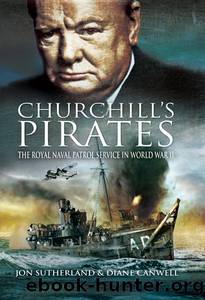Churchill's Pirates by Jon Sutherland Diane Canwell

Author:Jon Sutherland, Diane Canwell [Jon Sutherland, Diane Canwell]
Language: eng
Format: epub
Tags: History, Military, World War II, Naval
ISBN: 9781844687800
Google: YpLHDwAAQBAJ
Publisher: Pen and Sword
Published: 2011-02-23T00:39:38+00:00
CHAPTER EIGHT
Up to Full Strength
On 6 January 1944 the Leith-built Royal Naval Patrol Service trawler, Wallasea, was escorting a convoy from the Bristol Channel to Plymouth. She was attacked by a group of E-boats in Mounts Bay, Cornwall. The E-boats sank her, along with two of the convoy.
Three days earlier, on 3 January, the Aberdeen-built trawler Pine was also on escort duty, this time off Selsey Bill. She was attacked by three separate E-boat flotillas. The Pine had her bows blown off by a torpedo but she remained afloat, trying to fend off the E-boats. Despite her efforts two of the merchant ships were sunk. Help finally arrived, but the courageous little trawler sank whilst in tow en route to Portsmouth.
Another near miss in January was the former Belgian trawler that had been converted to a French minesweeper and then had become part of the Royal Naval Patrol Service, Cap dâAntifer. She was working off the Humber when she was attacked by four E-boats. She managed to drive them off but in the following month, on February 13, she was not so lucky. A flotilla of E-boats attacked her whilst she was minesweeping, again off the Humber. A torpedo sent her to the bottom in a matter of minutes.
By the spring of 1944 the Royal Naval Patrol Service was up to full strength, with 57,000 officers and men. The vast majority were âhostilities onlyâ men. There was still an enormous amount of work to be done in the build up to the liberation of Europe and, ultimately, the defeat of Japan. The duties were still as varied as ever: there were convoys in ever-increasing size to be protected; thousands of mines still to be swept; and the ever-present danger of U-boats.
A relatively small convoy, consisting of three merchantmen, had left Loch Ewe on the northwest of Scotland heading for Iceland. Their escorts were the trawlers Northern Spray and Veleta. Also attached to the convoy was the 1913 Aberdeen-built Strathella. She had been carrying out duties as a harbour defence patrol craft off Iceland and had two 6-pdr guns and a pair of Browning machine guns for anti-aircraft work. She also carried an asdic set and depth charges. The trawler, which had been taken over by the Royal Navy in 1940, was commanded by Temporary Lieutenant Osmund Lee, RNVR. He had had no nautical experience before joining the reserve in 1941. The trawler carried a crew of twenty, most of whom were seasoned fishermen. They had spent several months working out of Iceland and had then been sent to North Shields for a refit. From there she had gone to Tobermory, where she had developed some engine problems and consequently she had gone to a repair yard at Oban. She was ready to join up with the convoy, where she took up station on the port beam. Veleta covered the starboard beam and Northern Spray led the procession.
The weather conditions were relatively good until dusk on 12 January. Shortly after midnight
Download
This site does not store any files on its server. We only index and link to content provided by other sites. Please contact the content providers to delete copyright contents if any and email us, we'll remove relevant links or contents immediately.
The Radium Girls by Kate Moore(11970)
100 Deadly Skills by Clint Emerson(4879)
Rise and Kill First by Ronen Bergman(4739)
The Templars by Dan Jones(4656)
The Doomsday Machine by Daniel Ellsberg(4449)
The Rape of Nanking by Iris Chang(4165)
Killing England by Bill O'Reilly(3968)
Hitler in Los Angeles by Steven J. Ross(3923)
Stalin by Stephen Kotkin(3918)
12 Strong by Doug Stanton(3526)
Hitler's Monsters by Eric Kurlander(3291)
Blood and Sand by Alex Von Tunzelmann(3164)
The Code Book by Simon Singh(3136)
Darkest Hour by Anthony McCarten(3096)
The Art of War Visualized by Jessica Hagy(2973)
Hitler's Flying Saucers: A Guide to German Flying Discs of the Second World War by Stevens Henry(2731)
Babylon's Ark by Lawrence Anthony(2648)
The Second World Wars by Victor Davis Hanson(2502)
Tobruk by Peter Fitzsimons(2478)
